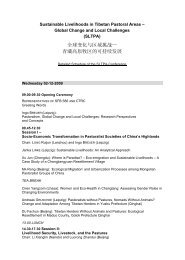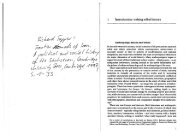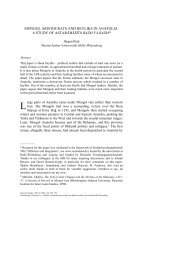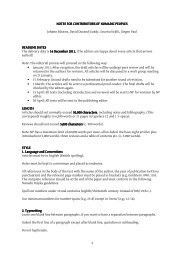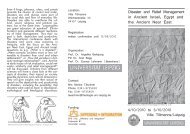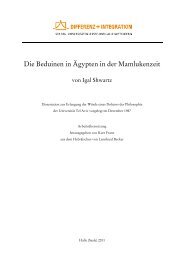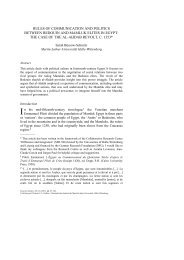Lozanka Peycheva, Ventsislav Dimov - SFB 586
Lozanka Peycheva, Ventsislav Dimov - SFB 586
Lozanka Peycheva, Ventsislav Dimov - SFB 586
You also want an ePaper? Increase the reach of your titles
YUMPU automatically turns print PDFs into web optimized ePapers that Google loves.
<strong>Lozanka</strong> <strong>Peycheva</strong>, <strong>Ventsislav</strong> <strong>Dimov</strong>: The Gypsy Music and Gypsy Musicians' Market in Bulgaria.<br />
in: Bernhard Streck (Hg.): Segmentation und Komplementarität. Organisatorische, ökonomische und<br />
kulturelle Aspekte der Interaktion von Nomaden und Sesshaften. Beiträge der Kolloquia am 25.10.2002<br />
und 27.06.2003. Halle 2004 (Orientwissenschaftliche Hefte 14; Mitteilungen des <strong>SFB</strong> „Differenz und<br />
Integration“ 6) S. 189–205.<br />
© <strong>Lozanka</strong> <strong>Peycheva</strong>, <strong>Ventsislav</strong> <strong>Dimov</strong> 2004
The Gypsy Music and Gypsy Musicians’ Market in<br />
Bulgaria<br />
<strong>Lozanka</strong> <strong>Peycheva</strong> & <strong>Ventsislav</strong> <strong>Dimov</strong><br />
The problem of music and musicians’ market has been a very important<br />
aspect of the functioning of Gypsy music in Bulgaria. It concerns both the<br />
folk and popular music that is performed by Gypsy professionals to serve<br />
the needs of different types of communities rural and urban, having versatile<br />
ethno-confessional profile (Bulgarians, Gypsies, Turks, Bulgarian<br />
Muslims, foreigners). The music played by professional Gypsy musicians<br />
has been a part of the rituality, festivity and entertainment of large<br />
audiences.<br />
Doubtless, the professional life of Gypsy musicians does bear the<br />
characteristic features of nomadism owing to migration around the music<br />
as well as to migration to the customer. This is a migration from the musicians’<br />
home places to other regions and settlements demanding their services;<br />
from their homes in the Gypsy neighbourhoods to the house, square<br />
or restaurant whereat their audience is feasting; from the podium at the<br />
public house to the table of the customer whom they treat with a<br />
“personalized” piece so that they could get an extra tip called parsa.<br />
Hence, it can be stated, that unlike the performers of art music Gypsy<br />
musicians have no constant house that is frequented by a chosen audience.<br />
Their “house” and “stage” are the roads, the migration to different<br />
audiences. Created and developed on those roads, the music performed by<br />
the Gypsy musicians also has nomadic character – it is mobile (having a<br />
flexible repertoire always sensitive to the environment), adaptive (being<br />
oriented to the current demands) and vendible (it is offered to well-to-do<br />
customers who can afford the entertainment). The gypsy music is to a<br />
great extend freed from the conservative norms of the established musical<br />
traditions.<br />
Mitteilungen des <strong>SFB</strong> <strong>586</strong> „Differenz und Integration“ 6
190<br />
LOZANKA PEYCHEVA & VENTSISLAV DIMOV<br />
1. The Gypsy Music<br />
Regardless to the territories they inhabit, the names they are called, the<br />
stereotypes applied to them by the host ethnic communities, the Gypsies<br />
have always been associated with music and the music gift. The music<br />
performed by professional Gypsy musicians can be called Gypsy as far as<br />
Gypsies produce it. In fact, this is hybrid music whose style, genre and<br />
repertoire are hard to define uniformly.<br />
Starting from the 1850s one can paint several characteristic portraits of<br />
Bulgarian Gypsy music and Gypsy musicians.<br />
In the 19 th century, the Gypsies were professional musicians called<br />
kemendjii (kemanci< Turk. ‘violinist’) who played the rebeck or violin,<br />
calgadjii (calgici< Turk. ‘player, musician’) who played in small orchestras<br />
combining local, Oriental and Western instruments and repertoire – very<br />
popular in the Balkan towns. As members of military bands, they used to<br />
play the zurnas and cattle drums during the Ottoman age. Later they<br />
started playing the brass instruments. Those 19 th century musicians used to<br />
play Bulgarian folk music, Turkish, Balkan towns music, West-European<br />
light and military music. In contrast to population of other Gypsy groups<br />
they are usually described as well off, smart people, as travelling, inter-city<br />
musicians.<br />
In the 20 th century there were certain types of bands set up by Gypsy<br />
instrumentalists: zurnaci bands (comprising two/three zurnas and a tapan<br />
– drum); calgaci (comprising several different instruments: a violin,<br />
clarinet, lauta – a kind of cither, tambura – a mandolin, cymbal, tapan, and<br />
later accordion); brass bands; wedding orchestras. The latter occurred in<br />
the 1960s as a combination of acoustic and amplified instruments (clarinet,<br />
saxophone, accordion, electric guitar, synthesizer, percussion section).<br />
The professional Gypsy musicians are nomads in their thinking as well<br />
– bearers of ancient and local folk traditions, all the while being open to<br />
the European music practice in the form of note literacy, music repertoire<br />
and functioning of the music itself. The melodies played by the professional<br />
Gypsy musicians are various in their origins and addresses:<br />
Bulgarian, Turkish, Greek, Albanian, Armenian, Serbian, Rumanian,<br />
Russian, West-European, part of the traditional Bulgarian, Balkan,<br />
Oriental, or later on the newer author, Western music, etc. In the second<br />
half of 20 th century Gypsy musicians are authors and performers of the<br />
most popular and best-sold music in Bulgaria – the music of the wedding<br />
www.nomadsed.de/publications.html
GYPSY MUSIC IN BULGARIA<br />
orchestras, and in the 1990s defined as ethnopop music, called calga<br />
[<strong>Peycheva</strong>, 1999:21–22; <strong>Dimov</strong>, 2001:101, 116].<br />
2. The Community of Gypsy Musicians<br />
Traditionally the Gypsy musicians are typical service nomads but nowadays<br />
those in Bulgaria are characterized by a sedentary way of life. Their<br />
families inhabit houses larger and nicer than the other homes in the Gypsy<br />
neighbourhoods. It is worth stressing that despite classifying them to the<br />
groups leading sedentary way of life, the fact that their trade involves<br />
travelling should be always kept in mind. The Gypsies play and sing visiting<br />
their customers. Offering their music as a commodity or a service is a<br />
kind of a service nomadism: namely when viewing the migration to the<br />
customer as well as serving the customers as a process.<br />
The demand and the high remuneration of the professional Gypsy<br />
musicians reveal the importance of service they do in society. Despite<br />
being of high importance, the musicians have a low status in the local<br />
society [Merriam, 1964:136–137]. Underestimated and ignored as a social<br />
and ethnic group, as a rule the Gypsy musicians dwell in neighbourhoods,<br />
separated from the rest population, although they are acknowledged as a<br />
persistent element of the most important feasts of the non-Gypsy communities.<br />
Similar dualism: a group of low place in the social hierarchy<br />
having a high demand and importance in the life of higher social circles is<br />
observed for the professional musicians and nomadic actors both on the<br />
Balkans and in Asia: barbiere in Afghanistan, the low caste of kusles and<br />
damai in Nepal [Hoerburger, 1976:28].<br />
Some traditional cultures are known to have social grouping of musicians<br />
in professional guilds. They are characteristic of their own subordination,<br />
inner segregation according to particular features, specific language<br />
and rituals [Merriam, 1964:140–143]. There is no information about such<br />
formal organization (musicians’ guild, craftsmanship) of the Gypsy musicians<br />
in Bulgaria. It can be assumed that they do have some (though<br />
informal) unions of their own. The members of this community differ in<br />
their trade, which is highly praised and well paid. The maestros know each<br />
other, have talks over the commissioning of their groups, train apprentices<br />
and assistants, whom promote later as maestros. The historic sources show<br />
that in the 19 th century the zurnaci formations used to be among the bestpaid<br />
and most prestigious groups commissioned by wealthy people to<br />
Mitteilungen des <strong>SFB</strong> <strong>586</strong> „Differenz und Integration“ 6<br />
191
192<br />
LOZANKA PEYCHEVA & VENTSISLAV DIMOV<br />
serve the feasts of their commons, families or guilds. It is known that they<br />
used to celebrate their professional (guild) holiday on January 17, the Day<br />
of St. Anthony [Tsepenkov, 1972:18–26]. Their descendants are still keeping<br />
the guild consciousness. The Gypsy zurnacies are professionals, craftsmen<br />
who make their living playing music, offering the product of their<br />
work to territories conquered by their music. The famous groups have<br />
divided the markets in the region of their business. The zurnacies from the<br />
town of Gotse Delchev say: “The Checha (a region in the high parts of the<br />
Pirin and the Western Rhodopes mountains) is our own market. It is the<br />
Checha that’s feeding us” [<strong>Peycheva</strong> & <strong>Dimov</strong>, 2002:64–67].<br />
The informality of the community of Gypsy musicians in Bulgaria continues<br />
in the social situating in the state. They sell their specific well-paid<br />
labour beyond any state regulations like social security, taxes or fares.<br />
Therefore, it could be said that the music profession of a greater part of the<br />
Gypsies is a kind of grey economy. Quite often, not only the authorities<br />
but the musicians as well are unaware of their own income. Those playing<br />
in the wedding orchestras – very fashionable and highly paid groups in the<br />
1980s say: “Then I used not to know my money”. There is information<br />
that during the socialist period (1944–1989) the Gypsy musicians were<br />
prosecuted by the militia (socialist times police) for not having a socially<br />
useful job. The zurnaci A. M. from Gotse Delchev remembers: “The<br />
people used to work for 60 levs. Muti and I used to go to there on<br />
Saturday and get 150. Even 300 levs. Even the MVR (Abbreviation of the<br />
Ministry of Home Affairs – n. a.) used to prosecute us to go to work. And<br />
we escaped from the MVR. Why will I go to work for 60 levs? Them did<br />
not count this being a musician to be a profession.” As seen in the 1960s<br />
and 1970s the Gypsy zurnacies used to earn a lot more than the average<br />
monthly salary in the country. The authorities accused them of not<br />
working (at that time it was obligatory to be employed – n. a.) but the<br />
musicians used to have the self-consciousness of professionals being a part<br />
of the traditional craftsmen’s guilds in the town (those of the showmakers,<br />
smiths, bell-makers, cattle-dealers, etc.).<br />
Professionalism is one of the trademarks of Bulgarian Gypsy musicians<br />
and their music. It is valid at the same extent for calgacies travelling all over<br />
the country in the past, for the members of the military bands in the Ottoman<br />
Empire and later of the military bands of the restored Bulgarian state<br />
as well as for the contemporary virtuosos from the wedding orchestras and<br />
www.nomadsed.de/publications.html
GYPSY MUSIC IN BULGARIA<br />
stars of Bulgarian music industry. Those are the Gypsy professionals<br />
having universal repertoire and ethnically conglomerate audience, musicians<br />
flattered by high demand and payment.<br />
According to Tax Registers during the times of the Ottoman Empire<br />
(15 th –19 th century), the musician’s craft used to be the most practiced by<br />
Gypsies from Bulgarian territories [Marushiakova, Popov, 2000:48–49].<br />
After the liberation of Bulgaria from the Ottoman rule in 1878, the<br />
professional Gypsy musicians became members of the newly founded<br />
military and hall bands. However, their chief realization is connected with<br />
travelling and offering their musicians services to the feasts and the<br />
entertainment in villages and towns. The data of the English Gypsylogist<br />
Petulengro who described the Gypsies from Northeast Bulgaria in the<br />
early 20 th century show two groups of Gypsies defined as musicians. A<br />
part of the larger group belongs to those leading sedentary way of life. The<br />
first are called davulci and mehter (probably descendants of the Ottoman<br />
military musicians – zurnacies and tapancies met nowadays in South-West<br />
Bulgaria). The other ones are denoted as calgacies or musicians popular as<br />
drandars. Their centre is the town of Kotel but they live in other places<br />
(Dobrich, Varna, Shumen, Sliven). Noteworthy is the fact that musicians<br />
are classified as sedentary remarking “that as a rule they play at all fairs”<br />
[Marushiakova, Popov, 1993:130]. Nevertheless, having in mind that playing<br />
at fairs imposes migrating life style one could doubt that the musicians<br />
are 100% sedentary.<br />
3. Market forms of music nomadism practiced by Bulgarian Gypsies<br />
Regardless of the tendencies to established sedentary way of life the professional<br />
Gypsy musicians were still practicing different forms of service<br />
nomadism in the 20 th century. Travelling to the markets of their musicians<br />
labour, they expand the territories spatially (as roads, places, states) and<br />
musically (music instruments, formations, style, genre, repertoires). The<br />
most customary forms of Gypsy music nomadism are: performing at<br />
circus shows, at fairs, shows with tame animals, playing at public houses,<br />
season performances as tourist attractions, street performances, music<br />
gurbet (Gastarbeit) abroad.<br />
The professional musicians belonging to the Ljaskovets and Kotel<br />
Gypsy groups are descendants of the drandars mentioned by Petulengro.<br />
Mitteilungen des <strong>SFB</strong> <strong>586</strong> „Differenz und Integration“ 6<br />
193
194<br />
LOZANKA PEYCHEVA & VENTSISLAV DIMOV<br />
Currently most of them are members of groups playing at weddings and in<br />
restaurants, more rarely in brass bands. But their grandfathers used to<br />
roam around the country and play with the circus and military bands.<br />
They used to play at the fairs as well.<br />
Playing at the circus shows is one of the typical forms of seasonal<br />
service nomadism practiced by Gypsy musicians. In the past those musicians<br />
were insulted for being nomads and travelling with their whole<br />
families: „They are mocking them because their wives accompany their<br />
men. And they sleep there in the circus. Even when pregnant, the women<br />
accompany their husbands. And when a child is born they have no diapers<br />
and wrap the infant in placard sheets. The whole families are on the road“<br />
[H. Ch.]. Musicians from Ljaskovets, Kotel, Zlataritsa, Sliven, and Popovo<br />
used to play at the circus shows. There used to be competitions between<br />
travelling circuses and between circus music groups. The clarinet player M.<br />
T., a descendant of a music clan from Ljaskovets, retells the story of his<br />
grandfather: „Every August seven circus companies used to gather in Stara<br />
Zagora. It used to be a music competition of that time musicians… They<br />
used to advertise their circus. The people would say: “That’s the best<br />
music we’ll see the show of this circus! They used to judge according to<br />
the music. All the time before the show of the company they used to play<br />
in front of the tent. My granddad says, other musician used to come to<br />
deteriorate our performance, different tricks to make, so that they could<br />
earn something too. Everybody used to want money! Different tricks –<br />
they used to eat lemons… It used to be in 1936. My granddad belonged to<br />
the group of Asen Aivazov, the bandmaster of the Ljaskovets Circus. The<br />
circus of Kotel used to be managed by the Bilnikovs, by the Malakovs.“<br />
We have copies of the membership cards issued to the Gypsy musicians<br />
by the Union of Circus Actors in Bulgaria. The cards and the oral stories<br />
recorded from contemporary musicians evidence that between the 1920s<br />
and 1940s there used to be many Gypsy musicians members of the<br />
numerous circus companies in Bulgaria. The bands used to be chiefly of<br />
brass instruments and had several functions in the shows: signalling the<br />
arrival of the circus, advertising of the forthcoming spectacles, gathering<br />
the audience with music, accompanying to the tricks of the circus actors,<br />
filling the pauses between each two tricks. The Gypsy musicians and their<br />
families used to spend the warmer half of the year with the circus on the<br />
road.<br />
www.nomadsed.de/publications.html
GYPSY MUSIC IN BULGARIA<br />
Playing at fairs is another form of seasonal service nomadism practiced<br />
by the Gypsy musicians in Bulgaria. The Bulgarian fairs – panairi (M.<br />
Greek panegyris – gathering of a large mob) are held annually on special<br />
dates usually in the summer half of the year. Besides the markets they are<br />
famous with the specific entertainment. They used to have the function of<br />
important events in the economic and cultural life of the local and supra<br />
local communities – regional (including several villages), district ones<br />
including a certain area of the country (Thrace, Dobrudzha, Strandzha). At<br />
fair time (lasting up to ten days) the music band is among the major<br />
entertainers: it accompanies the horo (traditional group dance); it performs<br />
at table in the temporary pavillions wherein one is being served not only<br />
food but music and dances as well; it performs at the fair circus shows;<br />
accompanies the shows of the tamed bears or monkeys; as well as the<br />
wrestling competitions.<br />
During the first half of the 20 th century professional Gypsy musicians<br />
used to play at the district fairs. The proprietors of the fair pubs (temporary<br />
restaurants in large tents) used to choose popular maestros whose<br />
music could attack the customers. According to the information we have,<br />
there used to be several ways to chose and commission the musicians. The<br />
proprietors used to choose musicians well known to the public – famous<br />
local names, gramophone record stars (like the Gypsy clarinettist Ramadan<br />
Lolov). Some of the owners of fair pubs used to travel around other fairs<br />
and commission the musicians they have already heard and liked. Often<br />
the active side of the music bargain used to be the musicians who went<br />
around the fair pubs and offered their services.<br />
The fairs are the site whereas the musicians meet, exchange their ideas<br />
and repertoire, form new bands. It is not a rare phenomenon for a fair<br />
band to comprise celebrities and unknown musicians from different parts<br />
of Bulgaria: a clarinettist from Sliven, a violinist from Shumen, cymbalist<br />
from Plovdiv, etc. Many Gypsy bands meet at such fairs and compete in<br />
attracting customers for their pubs or circuses. The players from the fair<br />
bands have a universal repertoire so that the taste of any audiences could<br />
be pleased – village folks, towns folks, Bulgarians, Turks, etc.<br />
The fair singers and fair songs are bound genetically and functionally to<br />
the fairs. The fair singers are travelling professional musicians, mostly<br />
Gypsies, who sing traditional songs and songs of their own composition.<br />
The songs sung to the accompaniment of a harmonium have usually melo-<br />
Mitteilungen des <strong>SFB</strong> <strong>586</strong> „Differenz und Integration“ 6<br />
195
196<br />
LOZANKA PEYCHEVA & VENTSISLAV DIMOV<br />
dramatic, novelistic character. The Gypsy musician from Yambol, Marin<br />
Parushev (1860–1914), was the first to do business playing the harmonium<br />
and selling booklets with the songs he was singing. His son, Parush<br />
Parushev (1885–1936) continued his father’s business and modernized it,<br />
recording fair songs. The Parushevs are the most popular Bulgarian musicians<br />
in the genre. Their family name became a synonym to a fair singer.<br />
Fair singers are typical travelling musicians who earn their living by performing<br />
outdoors. Usually an umbrella protects them and the harmonium<br />
from the rough weather. At certain intervals they offer the audience songbooks<br />
containing the texts of songs performed. Contemporaries of the fair<br />
singers state that they used to be extremely popular, especially among<br />
women and old people. Often the listeners forgot to do their shopping<br />
which was in fact the reason to come to the market or the fair.<br />
Playing for the tamed bear shows at the fairs is another form of musical<br />
nomadism. The music is performed by Gypsies Ursars (Lingurs) who tame<br />
animals (bears and monkeys) and give shows with them to a music<br />
accompaniment – playing and/ or singing. The typical instruments used<br />
for such shows are the tambourine, rebeck, nowadays even accordion. The<br />
repertoire is predominantly compounded of Bulgarian rustic folklore<br />
pieces. The musicians travel with their families during the summer half of<br />
the year. After the performance of the husband and the tame bear the wife<br />
and the kids go around with the hat. Though in a reduced scale, this practice<br />
is still vital. The greater part of Gypsies bear-tamers live in the village<br />
Yagoda, Stara Zagora region.<br />
A new type of seasonal music nomadism – the tourist, emerged in the<br />
1930s. It was connected with the tourist industry of modernizing Bulgaria.<br />
Professional musicians as a rule are among those who played pop music<br />
(light genre music). Thus it was easy to become tourist nomads going to<br />
work at ale-houses, night clubs and casinos on the Black Sea coast. Some<br />
of them were the popular Gypsy musicians like that time star violinist<br />
Atanas Sotirov – the Golden Gypsy Boy. In the second half of the 20 th<br />
century the Gypsy music and Gypsy musicians were widely implemented<br />
for tourist attractions. Musicians, singers and dancers formed different<br />
groups, even ensembles. Special restaurants like Tsiganski Tabor (The<br />
Gypsy Camp) at the Golden Sands near Varna with Gypsy shows were<br />
opened. The musicians, playing at the shows in the resorts reside there<br />
during the summer season. They get a set salary but rely much more on<br />
www.nomadsed.de/publications.html
GYPSY MUSIC IN BULGARIA<br />
the tips from the customers – called parsa, rasachka (dropping). Playing at<br />
resorts is a part of the professional vitae of the most prominent Gypsy<br />
musicians in Bulgaria: Peyo Budakov, Hasan Chinchiru, <strong>Ventsislav</strong> Takev,<br />
Mokolu, and Chirpanovs.<br />
In the past and nowadays one encounter the street Gypsy musicians<br />
who play in the underground passages, in parks, on the side walks, or in<br />
tram cars. Though this kind of job is not prestigious at all, the musicians<br />
have the confidence of professionals, performing class music. This selfconfidence<br />
has been demonstrated by the cymbalist M. A. who used to<br />
play with his whole dignity in the streets of the Old Plovdiv and in the<br />
central underground passage in the city. Whenever a customer would drop<br />
a small coin he would reject it: “Take it, it is no a small change music.”<br />
Until the 1950s the Gypsy musicians used to do their job usually travelling<br />
around the country – playing at fairs, weddings, village and town<br />
feasts, circus shows and resorts. In the second half of the 20 th century the<br />
routes expanded to Europe and other parts of the world. Their music trips<br />
could be called trans-border nomadism. The transformation of the musicians’<br />
routes is revealed by the number of biographic stories of famous<br />
musicians. The grandfather of the clarinettist M. T. used to travel all<br />
around Bulgaria with the Ljaskovets Circus. The grandson lives and plays<br />
in Sofia but seeks his realization abroad – he has been on tours in Greece<br />
and South France.<br />
The already mentioned forms of service nomadism – local, inter-city,<br />
supraregional and trans-border are one of the core characteristics of<br />
Gypsy music and Gypsy musicians in Bulgaria during the second half of<br />
the 20 th century. They are illustrated by the fates of professional Gypsy<br />
musicians, who are still playing in different bands.<br />
The zurnacies D. K. and S. K., a father and son, though living in the<br />
village of Kavrakirovo, Petrich region, travel all around South-West Bulgaria<br />
with their group playing at weddings, sabors and other local feasts.<br />
The saxophone player Yu. Yu. from Haskovo began to play in the<br />
Gypsy neighbourhood but became a national celebrity with a couple of<br />
wedding orchestras. He went on West European tour with Ivo Papzov’s<br />
group. Now he lives in the USA and has his own group that makes tours<br />
around America, Australia and Europe.<br />
Mitteilungen des <strong>SFB</strong> <strong>586</strong> „Differenz und Integration“ 6<br />
197
198<br />
LOZANKA PEYCHEVA & VENTSISLAV DIMOV<br />
The trumpet player A. T. is a descendant of the Gypsy clan of<br />
“blowers” from the Kotel region. He lives in Sliven but his brass band has<br />
played in large Bulgarian towns. Lately he and the Karandila band conducted<br />
by him have been on tours in Germany, Italy and other European<br />
countries.<br />
More examples of the dynamics of music nomadism can be brought up.<br />
But we find that those referred to illustrate elaborately the motion from<br />
tradition to modernity as well as that from the local to global as far as the<br />
Bulgarian market of Gypsy music is concerned.<br />
4. The notion market of Gypsy musicians. Commissioning, fees and<br />
parsa.<br />
Most often the musicians relate the term “market” (BG pazar) with bargaining<br />
(pazarene) and contracting (pazarlik), namely with negotiating the<br />
fee for their performance.<br />
Bargaining and negotiations on the payment of the musicians’ work go<br />
between the customers and the musicians. The clarinet player V. P. a leader<br />
of a wedding orchestra describes the process as follows: “There comes the<br />
man and says what we’re supposed to play and how long. He sets his<br />
terms, and I, if having the possibility, make amends. I say the most complicated,<br />
it’s the money bargain, the price.” If the bargain is successful the<br />
musicians receive a prepayment (caparo). Having kept the settled contract<br />
they get the rest of the sum.<br />
There is no unified fee for the musicians’ services. The payment is<br />
different for the various places and regions. It depends on the occasion, on<br />
the type of band, on the popularity and skill of the musicians, etc. In 1980s<br />
and 1990s the best-paid bands used to be the wedding orchestras from<br />
Thrace. According to musicians playing for Gypsies they used to get<br />
highest remuneration from the Kardarashi (This Gypsy groups is also<br />
called Goldsmiths, Grastars. They are related to the Tinkers and Neamtors<br />
who used to be nomads until the late 1950s). Between the 1960s and 1980s<br />
the fees of the zurnaci bands in South-west Bulgaria when playing at the<br />
weddings and circumcision parties (sünnets) of Bulgarian Muslims used to<br />
be very high. The professional Gypsy musicians share the opinion that in<br />
the last years the music market has been narrowing. It is because of the<br />
progressing impoverishment of the population. There have been less wed-<br />
www.nomadsed.de/publications.html
GYPSY MUSIC IN BULGARIA<br />
dings and family feasts with live music. For example 20 or 30 years ago a<br />
zurnaci band used to be paid several times more than the average monthly<br />
salary in the country. Now the same service is worth an average monthly<br />
salary.<br />
Usually the musicians are flexible and responsive to the terms of the<br />
payer in the bargains. They are willing to adapt to fees the customers could<br />
afford. In the recent years the fee that a player in a three member zurnaci<br />
formation quotes for playing at wedding, sabors banquets varies between<br />
20 and 50 levs per hour. The zurnaci from Razlog B. says about the<br />
bargains: “The bargain used to be quite harder in the past. Now it’s<br />
weaker. And I’m telling this before all colleagues – I charge 30 levs per<br />
hour. If the customers are poorer, I discount. What if there came a poorer<br />
customer wanting a whole day wedding. What if I strip him bear with an<br />
hour fee? A wedding’s not less eight or nine hours at least. Say them ten –<br />
that’s three hundred levs. I would say two hundred, a hundred and eighty,<br />
a hundred and sixty, to seem affordable for him.” Being real professionals,<br />
the zurnaci maestros from region have set a fee recommended for all the<br />
musicians. Bargain compromises are disapproved of as dumping the price<br />
devaluates the guild and skilfulness.<br />
The caparo (prepayment), parsa and rasachka (tipping) are terms also<br />
related to the remuneration of the musicians.<br />
Caparo (Italian caparra prepayment) is a certain sum negotiated between<br />
the musician and his customer. It is a guarantee that both parties<br />
have come to a contract. It most often occurs at the market of wedding<br />
music where the bands require usually 10% prepayment to confirm the<br />
commissioning. The prepayment of the customer and the oral promise of<br />
the musician are the seal of the deal. There have been few cases when the<br />
musicians did not keep the contracts. There is a telling about a Gypsy<br />
clarinet player called Kirish who did not keep his contract. Though having<br />
received a caparo to play at a Gypsy wedding, he went to play at another<br />
one. The band did not come, the wedding did not take place. So, the<br />
deceived parent, who had commissioned the clarinet player, found him in<br />
another village and shot him dead while playing in the presence of all<br />
guests of the wedding.<br />
Parsa (Turkish) is a synonym of giving a tip and giving money. It is the<br />
sum that musicians get from the audience before, after or in the course of<br />
their performance. The bank notes (rarely coins) are stuck to the forehead<br />
Mitteilungen des <strong>SFB</strong> <strong>586</strong> „Differenz und Integration“ 6<br />
199
200<br />
LOZANKA PEYCHEVA & VENTSISLAV DIMOV<br />
of the player, handed, or put into the instrument (dropped into the resonator<br />
of the rebeck, put into the folds of the accordion’s bellows, made<br />
into funnels and installed into the resonator holes of the zurnas, etc). After<br />
the performance the parsa is shared among the musicians. The good performance<br />
might be praised by a parsa overrating the remuneration that the<br />
musicians have been commissioned for. The rebeck player M. M. tells that<br />
he encountered such a thing when he played at a wedding in the village of<br />
Christo Milevo in Thrace.<br />
Giving parsa, sticking even gold coins to the foreheads of the musicians<br />
is a long time practice. There are reports of it even in the 19 th century. In<br />
the 1990s zurnacies mention large parsa got for their performances at weddings<br />
of rich Gypsies. “We got much money! Parsa! Five minutes –<br />
common this song, that song… They stuck here 200 levs” – tells the<br />
zurnaci L. F. According to S. K., a zurnaci from Petrich, another situation<br />
of getting a large parsa is playing to businessmen. His band was commissioned<br />
to play 6 hours for 250 levs. But he got much more as parsa. “But<br />
having begun to play, all of them were such businessmen, just putting<br />
money. It was money – a terrific thing… 620 was what only I got, you see,<br />
that what they stuck to me.” According to a zurnaci from Razlog, B., the<br />
largest parsa is got when playing in a public house: “Better off people<br />
come to the tavern I go to play, about “Dedo Pene” in Bansko... I’ve<br />
caught even six or seven thousand German marks there.”<br />
Rasachka (probably coming from the Bulgarian word russya – spending<br />
money carelessly) is another term of the extra payment the professional<br />
musicians get. The musicians playing at restaurants, pubs, bars, etc. are<br />
those that get such kind of payment. At a certain moment the musicians<br />
leave their habitual stage and go about the tables stopping to play for a<br />
particular customer inviting him to give a tip. The violinist B. B. relates<br />
rasachka to parsa. The difference is that in this case the initiative for a tip<br />
comes from the musician. Some of the young musicians start their career at<br />
the pubs playing for rasachka, without commissioning. Some find this job<br />
humiliating and regard it as a kind of begging. Others think that rasachka<br />
is a good school and helps promotion and establishment.<br />
5. The Market Place of the Musicians<br />
The community of professional Gypsy musicians have a specific term<br />
“musicians’ market place.” It is used to denote a set situation of profes-<br />
www.nomadsed.de/publications.html
GYPSY MUSIC IN BULGARIA<br />
sional communication between musicians. On such occasions they exchange<br />
information about music demands, music instruments, meet customers<br />
and negotiate performances. According to the Gypsy musicians the<br />
musicians’ markets are places for their professional contacts where<br />
sometimes they meet the customers as well. There are such places in the<br />
towns wherein the Gypsy musicians live.<br />
Usually the musicians’ market place is localized somewhere in the<br />
centre of the town. Usually it is a café, a restaurant, bar, ale-house, or the<br />
bar in a hotel lounge, which is significant for both musicians and the local<br />
people. The Gypsy men usually meet at some humble places in their<br />
neighbourhood or at such close to the town’s bus terminal, railway station<br />
or market place. In contrast, the Gypsy musicians prefer the prestigious<br />
places in the town, which are admired and frequented by the higher town<br />
circles. The markets take place on certain days of the week at a set time.<br />
The musicians from Sofia gather at a café in the heart of the city opposite<br />
the St. Nedelja Church, known as ‘The Priests’ every workday about<br />
noon. The musicians’ market in Plovdiv is held in a café close to the<br />
Maritsa chemist’s in the city centre on Thursdays. Sunday is meeting day<br />
of the musicians from Stara Zagora at the snack bar “Golden Thrace”.<br />
Those from Pleven open the market on Wednesdays in Orpheus Café next<br />
to the Osvobozhdenie cinema. Montana’s musicians come to the Courage<br />
Café in the city centre every Monday. The musicians from Vidin prefer a<br />
place of the state-owned Balkantourist, which they call „The former<br />
Bononia”. The players from Petrich know that they can meet each other<br />
every day at the bar of the state-owned Balkantourist hotel. Yet this<br />
information is about the meeting places in the mid 1990s [<strong>Peycheva</strong>,<br />
1996:376–377]. Now some of these places are closed or have changed their<br />
owners and names. But the musicians are still there. Usually their meetings<br />
are after 10 A.M. mostly about noon.<br />
When discussing the Gypsy musicians’ market one should bear in mind<br />
that this is not a pure Gypsy phenomenon as a notion and participants.<br />
Besides the Gypsy musicians the market places are visited by non-Gypsy<br />
musicians and customers – Bulgarians, Turks, Vlahs. Even musicians from<br />
the neighbouring Balkan countries (Serbia, Macedonia, Greece) do visit<br />
them. The musicians’ guild coming to the market place belongs to the<br />
circles of the local players and singers, who play live traditional and pop<br />
music at weddings, various family rituals and feasts, professional and town<br />
Mitteilungen des <strong>SFB</strong> <strong>586</strong> „Differenz und Integration“ 6<br />
201
202<br />
LOZANKA PEYCHEVA & VENTSISLAV DIMOV<br />
feasts. They also entertain the customers of different public houses –<br />
restaurants, taverns, and pubs. The musicians’ market places in the larger<br />
towns attract performers from the region and the district. Musicians from<br />
Lovetch, Vratsa, Montana, Teteven, Lukovit, and Vidin go regularly to the<br />
musicians market held in Pleven. The Thursday market in Plovdiv gathers<br />
musicians from Kardhzali, Haskovo, Pazardhzik, Stara Zagora, Sliven, and<br />
Yambol. Some years ago during our field research on zurnaci music we<br />
first met musicians from the villages around Petrich in the bar of the<br />
town’s hotel – that was their musicians’ market place.<br />
Our personal observations about the conduct at these market places are<br />
that the musicians treat themselves with a cup of coffee, a glass of beer or<br />
some drink. Sometimes they listen to music. But they mostly talk. Usually<br />
the talk is about matters concerning the trade of their music: commissioning<br />
to play at wedding or other feast, the music instruments, news<br />
about musicians, hits, albums, etc. Their meetings are a kind of musicians’<br />
exchange – they exchange information about the fees of trade (which<br />
region has more weddings, what’s the amount of parsa), they buy and sell<br />
music instruments and equipment, negotiate on changes in the bands’ staff,<br />
there the musicians are being commissioned to play by customers in<br />
demand. The musicians like talking about daily things too, gossiping about<br />
women, sharing their personal and family problems, commenting on town<br />
and political events. However, no matter how large the scope and contents<br />
of the information field of the musicians’ market is, it is focused upon the<br />
music and musicians’ trade.<br />
The interviews taken from Gypsy musicians confirm the conclusions<br />
from the observations. The musician D. from Stara Zagora confesses: “We<br />
talk many things at the market place. Whatever is eating up this or that<br />
one. About music, about women. We speak about the rates of music<br />
exchange – how much is a bargain, how much this or that a band got,<br />
where we are going to play at… People come and bargain to commission a<br />
band for a wedding. They are familiar with our gathering here on<br />
Saturdays.” The market place in Montana is seen through the eyes of the<br />
bandleader K. D. as follows: “We exchange various information. Musical<br />
information about instruments, sales, purchases. We talk about the music,<br />
about shows – who has done what.“<br />
The business tone of the atmosphere does not hamper the merrymaking<br />
and good moods reigning at the musicians’ market places. Jokes, funny<br />
www.nomadsed.de/publications.html
GYPSY MUSIC IN BULGARIA<br />
memories are told. There are many tricks and friendly mocking. We have<br />
witnessed how a confusing accident (a musician became a victim of<br />
drinkers’ fight) was presented with a good sense of humour and heartily<br />
laughed at. There are great masters of story telling amongst the Gypsy<br />
musicians who are able to turn a trivial event into an attractive tale. Some<br />
of them are the keepers of the oral local music annals – they have a<br />
permanent repertoire of memories and stories full of humour. The festive<br />
spirit in the musicians’ communication is sometimes expressed by a shared<br />
music making. We have witnessed spontaneous interruptions of the conversation<br />
by a bursts of singing or playing. As the mentioned above musician,<br />
K.D., says: „In the past the gatherings at the musicians’ market in<br />
Montana used always to end with joint playing. We used to make jam<br />
sessions. It was very nice. We used to have a small café and there we had<br />
collected equipment, everything. And everybody would get on the stage<br />
and play.”<br />
6. Summary<br />
Selling their music as a service the professional Gypsy musicians follow<br />
the sources of their living. The trip (in its direct and figurative sense) to the<br />
customer is a form of semi-nomadic way of living. The music instruments,<br />
the repertoire, the skill of the Gypsy musicians are the specific tools of the<br />
nomadism they practice. Beyond the economic aspects these tools of the<br />
musicians’ trade have ideological and symbolic aspects. Thus the music<br />
making can be treated not only as a trade but also as a sign of group<br />
identity.<br />
When making research on the market of Gypsy music and musicians in<br />
Bulgaria, at least two different points of view must be kept in mind – an<br />
inner one, belonging to the musicians and outer one, belonging to others.<br />
In our case we pay more attention to the inner point of view – that of the<br />
musicians. According to it, the values of musicians’ labour, of their profession<br />
and of their music are considerable. Our research on the market<br />
comes to prove this. From the traditional rituality to the contemporary<br />
festivity, the professional Gypsy musicians, as mediators are centres of the<br />
events, their music being a structuring part of these feasts and therefore<br />
Gypsies can be considered marginal only from a negative point of view.<br />
There may be another interpretation of the service nomadism of the<br />
Gypsy musicians. They are nomads both in their practice and in their way<br />
Mitteilungen des <strong>SFB</strong> <strong>586</strong> „Differenz und Integration“ 6<br />
203
204<br />
LOZANKA PEYCHEVA & VENTSISLAV DIMOV<br />
of musical thinking. The music they create is in the same time a challenge,<br />
a voyage, a surprise, and a thrill. Doubtlessly such music must be felt in<br />
order to be fully understood, for it cannot be completely described.<br />
Perhaps some forms of mental nomadism would be a suitable strategy to<br />
get oneself closer to the very heart of the Gypsy music. But this matter<br />
concerns other research.<br />
Bibliography<br />
<strong>Dimov</strong>, <strong>Ventsislav</strong>: Etnopopbumat (The Ethnopopboom). Sofia 2001.<br />
Hoerburger, Felix: „Die Zournas-Music in Griechenland. Verbreitung und<br />
Erhaltungszustand“, in: Kurt Reinhard (Hrsg.): Studien zur Music<br />
Südost-Europas. Hamburg 1976, 28–48.<br />
Marushiakova, Elena / Popov, Veselin: Ciganite v Bulgaria. (The Gypsies<br />
in Bulgaria). Sofia 1993.<br />
Marushiakova, Elena / Popov, Veselin: Ciganite v Osmanskata imperija.<br />
(The Gypsies in the Ottoman Empire). Sofia 2000.<br />
Merriam, Alan: The Anthropology of Music. Evanston 1964.<br />
<strong>Peycheva</strong>, <strong>Lozanka</strong>: “Varhu njakoi aspekti na socialnite kontakti pri<br />
romskite muzikanti v Bulgaria dnes” (“Reflection on Some Aspects of<br />
the Social Relations among the Gypsy Musicians in Bulgaria<br />
nowadays”), in: Problemi na sociolingvistikata 5. Ezikat I socialnite<br />
kontakti (Problems of Social Linguistics 5. Language and Social<br />
Relations). Sofia 1996, 374–378.<br />
<strong>Peycheva</strong>, <strong>Lozanka</strong>: Dushata plache – pesen izliza. Romskite muzikanti v<br />
Bulgaria I tjahnata muzika. (Your Soul cries and out comes a song.<br />
Romany/gypsies Musicians in Bulgaria and their Music.). Sofia 1999.<br />
<strong>Peycheva</strong>, <strong>Lozanka</strong> / <strong>Dimov</strong>, <strong>Ventsislav</strong>: The Zurna Tradition in Southwest<br />
Bulgaria. Sofia 2002.<br />
Tsepenkov, Marko: Materijali. Literaturni tvorbi. Kniga 10. (Materials<br />
from Field Research. Creations of Literature. Volume 10). Skopje 1972.<br />
www.nomadsed.de/publications.html
GYPSY MUSIC IN BULGARIA<br />
Informants<br />
A. M., 1958, clarinettist from Gotse Delchev. Interviewed in 2000.<br />
A. T., 1959, trumpet player from Sliven. Interviewed in 1995.<br />
B., 1958, Zurna player from Razlog. Interviewed in 2001.<br />
B. B., 1940, violinist from Sliven. Interviewed in 1999.<br />
D., 1957, guitar player from Stara Zagora. Interviewed in 1994.<br />
D. K., 1948, Zurna player from Kavrakirovo. Interviewed in 1992–2001.<br />
H. Ch., 1932–1994, violinist from Shumen. Interviewed in 1993.<br />
K. D., 1964, bass guitar player from Montana. Interviewed in 1994–1995.<br />
L. F., 1954, Zurna player from Kavrakirovo. Interviewed in 2000.<br />
M. M., rebeck player from Stara Zagora. Interviewed in 1995.<br />
M. T., 1970, clarinettist from Omurtag. Interviewed in 1994.<br />
M. A., 1923–2000, cymbalist from Razgrad. Interviewed in 1998.<br />
S. K., 1971, Zurna player from Kavrakirovo. Interviewed in 1994–2001.<br />
V. P., 1965, clarinettist from Kotel. Interviewed in 1994.<br />
Yu. Yu., saxophone player from Kardgali. Interviewed in 1994.<br />
Mitteilungen des <strong>SFB</strong> <strong>586</strong> „Differenz und Integration“ 6<br />
205



